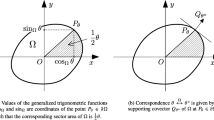Abstract
The connection between Markov’s theory of minima of indefinite binary quadratic forms and hyperbolic geodesics is well-known. We introduce some new analogues of the Markov spectrum defined in terms of modular billiards and consider the problem of characterizing that part of the spectrum below the lowest limit point.








Similar content being viewed by others
References
Aigner, M.: Markov’s Theorem and 100 Years of the Uniqueness Conjecture. A Mathematical Journey from Irrational Numbers to Perfect Matchings. Springer, Cham (2013)
Artin, E.: Ein mechanisches System mit quasiergodischen Bahnen. Hamb. Math. Abh. 3, 170–177 (1924)
Beardon, A.F.: The Geometry of Discrete Groups. Graduate Texts in Mathematics, vol. 91. Springer, New York (1983)
Berstel, J., Lauve, A., Reutenauer, C., Saliola, F.: Combinatorics on Words. Christoffel Words and Repetitions in Words. CRM Monograph Series, vol. 27. AMS, Providence (2009)
Bombieri, Enrico: Continued fractions and the Markoff tree. Expos. Math. 25(3), 187–213 (2007)
Cassels, J.W.S.: An Introduction to Diophantine Approximation. Cambridge Tracts in Mathematics and Mathematical Physics, No. 45. Cambridge University Press, New York (1957)
Cohn, H.: Approach to Markoff’s minimal forms through modular functions. Ann. Math. (2) 61, 1–12 (1955)
Cohn, H.: Markoff geodesics in matrix theory. In: Number Theory with an Emphasis on the Markoff Spectrum (Provo, UT, 1991), Lecture Notes in Pure and Applied Mathematics, vol. 147, pp. 69–82. Dekker, New York (1993)
Cusick, T.W., Flahive, M.E.: The Markoff and Lagrange Spectra. Mathematical Surveys and Monographs, vol. 30. American Mathematical Society, Providence (1989)
Dickson, L.E.: Modern Elementary Theory of Numbers. University of Chicago Press, Chicago (1939)
Dickson, L.E.: Studies in the Theory of Numbers. Chicago University Press, Chicago (1930)
Ford, L.R.: A geometrical proof of a theorem of Hurwitz. Proc. Edinb. Math. Soc. 35, 59–65 (1917)
Freiman, G.A.: Diofantovy priblizheniya i geometriya chisel (zadacha Markova). (Russian) [Diophantine approximations and the geometry of numbers (Markov’s problem)] Kalinin. Gosudarstv. Univ., Kalinin (1975)
Frobenius, G.: Über die Markoffschen Zahlen, Preuss. Akad. Wiss. Sitzungberichte (1913) 458–487 (also in: G. Frobenius, Gesammelte Abhandlungen, Bd. 3, Springer, Berlin, Heidelberg, New York, 1968, pp. 598–627)
Hall Jr., M.: On the sum and product of continued fractions. Ann. Math. (2) 48, 966–993 (1947)
Hall Jr., M.: The Markoff spectrum. Acta Arith. 18, 387–399 (1971)
Haas, A., Series, C.: The Hurwitz constant and Diophantine approximation on Hecke groups. J. Lond. Math. Soc. (2) 34(2), 219234 (1986)
Haas, A.: Diophantine approximation on hyperbolic Riemann surfaces. Acta Math. 156(1–2), 3382 (1986)
Lehner, J., Sheingorn, M.: Simple closed geodesics on \(H^+/\Gamma (3)\) arise from the Markov spectrum. Bull. Am. Math. Soc. (N.S.) 11(2), 359362 (1984)
Malyshev, A.V.: Markov and Lagrange spectra [Survey of the literature]. Zap. Nauch. Sem. Lenin. Otd. Math. Inst. V.A. Steklova AN SSSR 67, 5–38 (1977). (English translation in J. Soviet Math. 16 (1981) 767–788)
Markoff, A.: Sur les formes quadratiques binaires indéfinies. Math. Ann. 15, 381–409 (1879)
Markoff, A.: Sur les formes quadratiques binaires indéfinies. Math. Ann. 17, 379–399 (1880)
Sarnak, P.: Reciprocal geodesics. In: Analytic Number Theory, pp. 217–237, Clay Mathematics Proceedings, vol. 7, American Mathematical Society, Providence, RI (2007)
Schur, I.: Zur Theorie der indefiniten binären quadratischen Formen, Sitzungberichte der Preussischen Akademie Wiss. 212–231 (1913)
Acknowledgements
The second author thanks Alex Kontorovich for some enlightening discussions on the topics of this paper. The authors thank the referee for several constructive comments that have improved the exposition of this paper.
Author information
Authors and Affiliations
Corresponding author
Additional information
Communicated by Kannan Soundararajan.
In memory of Harvey Cohn (1923–2014)
Supported by NSF Grant DMS 1701638.
Rights and permissions
About this article
Cite this article
Andersen, N., Duke, W. Markov spectra for modular billiards. Math. Ann. 373, 1151–1175 (2019). https://doi.org/10.1007/s00208-018-1781-x
Received:
Published:
Issue Date:
DOI: https://doi.org/10.1007/s00208-018-1781-x



